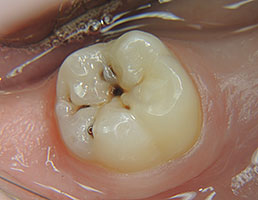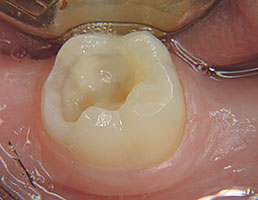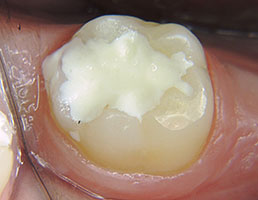G.I.Skripkina – PHD in medicine, head of pediatric dentistry cathedra, Omsk state medical academy
T.S.Mitiaeva – assistant of pediatric dentistry cathedra, Omsk state medical academy
Yu.G.Romanova – assistant of pediatric dentistry cathedra, Omsk state medical academy
«Cathedra» journal, No 47, 2014
Resume
The research on effectiveness of use of glass ionomers in pediatric dentistry has been based on 108 clinical cases of cure of uncomplicated caries on chewing and proximal surfaces of primary and permanent molars through preparation and sealing. The research was focused on clinical and in-vitro parameters of glass ionomers use effectiveness. It has been established that the best glass ionomers for use in pediatric dentistry are Fuji VIII (GC) and CemFil (Stomadent). These glass ionomers are the most convenient for a pediatric dentist to be used in clinic. They are capable of preserving their qualities for a long time after the seal has been made, which is important for prevention of complications of carious process among children.
Key words: glass ionomers, caries among children, technical qualities, pediatric dentistry practice
Actuality
The problem of choice of filling material in pediatric dentistry is quite important.
Main requirements to filling materials used for restoration of primary teeth include: lack of toxic harm; bio-compatibility; proper adhesion to hard teeth tissues; strengthening of the remaining tooth structure; easy installation; low cost. At present glass ionomers possess all these qualities. According to a number of authors’ opinion, if diametric strength of glass ionomers had been considerably higher, they would have become ideal filling materials for pediatric dentistry.
Glass ionomers appeared on the dental market in 1976. Since then there have been offered many modifications of their recipe aimed at the improvement of their qualities. The process of improvement still continues.
Depending of clinical use glass ionomers are divided in 3 types (McLean, 1998): those used for fixation, restoration and lining. In their turn restorative glass ionomers are further classified by T.P. Croll, J.W. Nickolson as self-cured (classic or traditional), metal-modified and polymer-modified [1, 3, 4, 5, 6].
It would be natural to put a question: which kinds of modern glass ionomers should be given preference in pediatric dentistry practice taking into account that each year there are more and more producers of glass ionomers?
Based on the above, we have set to ourselves the following research target: comparative evaluation of effectiveness of use of glass ionomers in pediatric dentistry practice.
Research material and method
To carry out research we have formed a group of 27 children aged 3-7 years. In total 108 clinical cases of cure of uncomplicated caries on chewing and proximal surfaces of primary and permanent molars through preparation and sealing have been accomplished.
To achieve purity of the experiment all glass ionomers have been divided in 2 groups: «Classic» group (powder+distilled water) and «Powder+liquid» group. «Classic» group in its turn was divided in two subgroups: «ART» subgroup («Aquion Art» (Vladmiva)), «Dentis Art» (Stomadent)) and «Mechanical processing» subgroup («Aqua Ionofil» (VOCO)), «ChemFil» (Stomadent)). «Powder+liquid» group was represented by «Cemion» (Vladmiva), «CemFil» (Stomadent), «Glassin Rest» (Omega-Dent), «Fuji VIII (GC). Clinical research was carried at pediatric dentistry cathedra, Omsk state medical academy. In vitro research was carried in the laboratory for research and physical-chemical tests of dental materials of Moscow central science-research institute of dentistry and jaw-facial surgery.
In clinical research we have paid attention to technical qualities of materials both during mixing and during restoration work. The evaluation was made using 5-grade system. After sealing we carried out dynamic observation – in 3 and 6 months – to check secondary caries and the quality of edge adhesion of the seal. Edge adhesion was tested with the use of «DentEst» device following G.G.Ivanova’s method. During in vitro tests the compressive strength and acid erosion have been analyzed.
Research results and their discussion
Research results are presented in tables 1, 2, 3.
Table 1. Results of clinical research of glass ionomers of the «Classic» group
| Qualities |
* Aquion Art (Vladmiva) |
* Dentis Art (StomaDent) |
ChemFil (StomaDent) |
Aqua Ionofil (VOCO) |
| Edge adhesion of the material in 3/6 months (microamperes) |
** 18-22
*** 20-25
/
** 25-30
*** 23-28 |
** 15-18
*** 17-22
/
** 20- 25
*** 18-22 |
** 13-15
*** 15-20
/
** 17-22
*** 20-24 |
** 13-18
*** 10-15
/
** 15-20
*** 17-21 |
| Convenience during mixing (grade) |
3 |
4 |
4 |
4 |
| Adoption to the cavity walls (grade) |
4 |
5 |
5 |
5 |
| Form after solidification (grade) |
3 |
4 |
4 |
4 |
| Material consistency (grade) |
4 |
5 |
5 |
4 |
| Adhesion to instruments (grade) |
3 |
4 |
4 |
3 |
| Solidification time/ working time (minutes) |
4-4,5
1,5-2 |
3-4
1,5-2 |
4
1,5 |
5-6
2,5-3,5 |
| Secondary caries in 3/6 months (+;-) |
-/+ by ART method |
- |
- |
- |
| Radiopacity (+;-) |
+ |
+ |
+ |
+ |
| Presence of conditioner (+;-) |
+ |
+ |
- |
- |
| Protective coating (+;-) |
+ |
- |
- |
Final Varnish LC |
| Preliminary/final processing |
15 min
24 hours |
7 min
24 hours |
7 min
24 hours |
4-6 min
24 hours |
* for materials marked ART we have used the ART method
** I class according to Black
*** II class according to Black
Table 2. Results of clinical research of glass ionomers of the «Powder+Liquid» group
| Qualities |
Cemion (Vladmiva) |
CemFil (StomaDent) |
Glassin Rest (Omega-Dent) |
Fuji VIII (GC) |
| Edge adhesion of the material in 3/6 months (microamperes) |
** 6-11
*** 7-13
/
** 10-15
*** 9-13 |
** 5-9
*** 2-7
/
** 9-11
*** 7-10 |
** 7-10
*** 5-12
/
** 10-15
*** 8-13 |
** 2-5
*** 3-8
/
** 5-9
*** 6-10 |
| Convenience during mixing (grade) |
4 |
5 |
4 |
5 |
| Adoption to the cavity walls (grade) |
4 |
5 |
4 |
5 |
| Form after solidification (grade) |
4 |
5 |
3 |
5 |
| Material consistency (grade) |
4 |
5 |
4 |
5 |
| Adhesion to instruments (grade) |
3 |
5 |
3 |
5 |
| Solidification time/ working time (minutes) |
5-5,5
2-2,5 |
3-4
2-2,5 |
5-6
1,5-2 |
2-3
1,5 |
| Secondary caries in 3/6 months (+;-) |
- |
- |
- |
- |
| Radiopacity (+;-) |
+ |
+ |
+ |
+ |
| Presence of conditioner (+;-) |
+ |
- |
- |
GS Caviti conditioner/GS Dentin conditioner |
| Protective coating (+;-) |
+ |
- |
(Recommended)+ |
GS Fuji Coat LS |
| Preliminary/final processing |
15 min
24 hours |
7 min
24 hours |
15-20 min
24 hours |
6 min |
** I class according to Black
***II class according to Black
Table 3. Results of in vitro tests of glass ionomers of the «Powder+Liquid» group
| Clause of GOST 51744-2001 requirement: |
Quality parameter |
Tests results |
| Fuji VIII (GC) |
CemFil (StomaDent) |
Glassin Rest (Omega-Dent) |
Cemion (Vladmiva) |
| Clause 5.12, table 1 |
Compression strength, MPA, not less than 130 |
194 |
183 |
127 |
139 |
| Clause 5.12, table 1 |
Acid erosion, not more than 0,05 mm/hour |
0.002 |
0.0072 |
0.101 |
0.002 |
| Clause 7.8 |
Color: samples of same color should have ΔÅ not more than 2.5 |
1.73 |
2.56 |
1.79 |
1.16 |
| Clause 7.14 |
Opacity Ñ 0.70 |
0.871 |
0.849 |
0.872 |
0.95 |
Source: Protocol of technical tests, Moscow central science-research institute of dentistry and jaw-facial surgery, 09.09.2013
The following results have been obtained. The best edge adhesion in the «Powder+liquid» group both after 3 and 6 months have been established for «Fuji VIII» (GC) and «CemFil» (StomaDent). Good results have been received while testing «Dentis Art» (StomaDent) material in the «Classic – Art» subgroup. In the «Classic – Mechanical processing» group the results for the materials have been practically similar.
Best technical qualities have been established for «Fuji VIII» (GC), «CemFil» (StomaDent), «ChemFil» (StomaDent), «Dentis Art» (StomaDent) and «Aqua Ionofil» (VOCO).
It is very important for clinical dentistry that all materials proved to be radiopaque. This quality of glass ionomers simplifies for the doctor the task of secondary caries diagnostics and of controlling edge adhesion of II class seals by Black.
Some glass ionomers chosen had conditioner attached, the other did not have it. The use of conditioner may improve the quality of adhesion, but it is not convenient for use in pediatric dentistry practice, so its presence in the set of filling material is rather a disadvantage than advantage. Long curing time of filling material is another disadvantage for pediatric dentistry.
The results of in vitro tests in the «Powder+liquid» group (table 3) show that «Fuji VIII» (GC) and «CemFil» (StomaDent) have the best compressive strength. «Glassin Rest» could not withstand even the minimal load of 130 MPa (the compressive strength parameter amounted to 127 MPa). Neither «Glassin Rest» could hold to the minimal level of acid erosion.
Clinical case: by patient V., 8 years old, a hidden carious cavity in 4.6 tooth was discovered. Electrical conductivity of enamel of the tooth fissure amounted to 2.5 microamperes, which indicates to presence of carious cavity within enamel and dentin area (Pic. 1). It was decided to cure dentin caries through preparation and sealing with the use of glass ionomer «CemFil» (StomaDent).

Pic. 1. Fissure caries in 4.6 tooth |

Pic. 2. Prepared carious cavity in 4.6. tooth |

Pic. 3. The seal made of glass ionomer «CemFil» (StomaDent) |
In order to open the carious cavity, all enamel having no dentine base was taken out. During necrotomy stage a micromotor and caries-marker control have been used. While forming the cavity, oval/mild contours, without acute angles, have been made. Treatment with medicine and drying of carious cavity has been performed (Pic. 2).
The seal made of glass ionomer «CemFil» has been installed (Pic. 3). The functional state of the seal was evaluated 3 and 6 months later, when edge adhesion of the seal and presence of secondary carious process was checked. The tests were performed with the use of objective research method – electrometry. We used electrical-diagnostical device «Dentest» produced by «Geosoft-Dent». Edge adhesion of the material in 3 moths after sealing amounted to 5 microamperes, in 6 months 8 microamperes, - which signifies a satisfactory result.
Conclusion. While analyzing results of clinical and in vitro tests of above mentioned glass ionomers, the following conclusion can be made: the best glass ionomers for use in pediatric dentistry are «Fuji VIII» (GC) and «CemFil» (StomaDent). These glass ionomers are the most convenient for a pediatric dentist to be used in clinic. They are capable of preserving their qualities for a long time after the seal has been made, which is important for prevention of complications of carious process among children.
Bibliography:
1. Äàããåë è äð. Àòëàñ ïî ðåñòàâðàöèè ìîëî÷íûõ çóáîâ. – Ì., 2001. – 134 ñ.
2. Èâàíîâà Ã. Ã. Ýëåêòðîìåòðè÷åñêèå ìåòîäû â äèàãíîñòèêå, ïðîãíîçèðîâàíèè, ïðîôèëàêòèêå, ëå÷åíèè îñíîâíûõ ïîðàæåíèé òâåðäûõ òêàíåé çóáîâ : ìåòîä. ðåêîìåíäàöèè / Ã. Ã. Èâàíîâà, Â. Ê. Ëåîíòüåâ, Ò. Í. Æîðîâà. – Îìñê, 1996. – 9 ñ.
3. Êîð÷àãèíà Â. Â. Ëå÷åíèå êàðèåñà çóáîâ ó äåòåé ðàííåãî âîçðàñòà / Â. Â. Êîð÷àãèíà. – Ì. : ÌÅÄïðåññ-èíôîðì, 2008. – 161 ñ.
4. Ñòîìàòîëîãèÿ äåòåé è ïîäðîñòêîâ: ïåð. ñ àíãë. ïîä ðåä. Ð. Ìàê Äîíàëüäà, Ä. Ýéâåðè. – Ì., 2003. – 766 ñ.
5. Albers H.F. Tooth-colored restoratives. Principles and techniques. Ninth Edition. – London, 2002. – 312 p.
6. McDonald R.E., Avery D.R. Dentistry for the pediatric and adolescence. – 1988. – 937 p.





